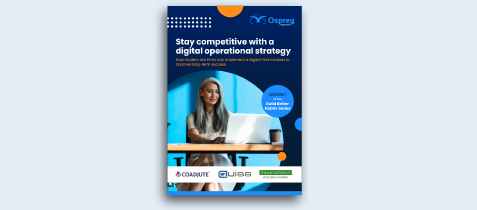Contents
How to be CQS compliant part 1: A guide to the new updates to the CQS Practice Management Standards
The Law Society published several changes and updates to the Conveyancing Quality Scheme (CQS) in May 2022 that affects over 3,000 law firms across the UK. In collaboration with InfoTrack and lead assessor for CQS, Tracy Thompson we’ve created a three-part guide and on-demand webinar that aims to help firms stay compliant and meet the Core Practice Management Standards.
In part one, Tracy details the changes that all firms need to be aware of to ensure they’re compliant and assessment ready.
For further advice and best practices, you can also view parts two and three of our CQS guide:
Part 2: 10 ways Osprey & InfoTrack can help law firms stay CQS compliant
Part 3: The common compliance pitfalls most SME law firms face and how to overcome them

How to stay compliant with the latest Conveyancing Quality Scheme requirements
The latest version of the CQS Core Practice Management Standards (CPMS) is now aligned with the Lexcel accreditation. So, if you’re Lexcel accredited then you should already meet approximately 50% of the requirements. The CQS CPMS now has seven chapters and an increase to 40 individual requirements.
Some areas may look different to what you’re familiar with because some of the text has been moved from the ‘requirements’ section to ‘guidance’ notes. Tracy advises that those requirements are still necessary, even though they’ve moved. The guidance notes set out the minimum expectations the Law Society expects of practices and provides more context to the requirements.
The changes you need to know for the 2022 CQS Core Practice Management Standards
Below Tracy Thompson outlines all changes and updates from the 2019 to the 2022 CQS Practice Management Standards to ensure your firm stays compliant.
1. Structure & Strategy and 2. Financial Management
There have been no significant changes to sections one and two of the Core Practice Management Standards.
3. Information Management
Within section 3.1 there is a new introduction to data protection requirements. Practices now need to make sure that all employees are cyber security trained and are aware of how information security risks could affect the practice. The most common cybercrime attack is phishing emails, therefore your practice is only secure if your team is trained to spot potential risks to avoid clicking on the wrong links in emails.
Section 3.3 is a new requirement that states all firms should have a register of each policy, plan, and procedure that is contained within the CPMS. The register should identify who is responsible for each particular requirement and ensure you have a corresponding procedure for reviewing the policies. Be careful of wording; if the CPMS states you must have a procedure, then the steps of your process needs to be written down and documented.
4. People Management
Chapter four is a new addition to the CPMS. The previous standards contained learning and development requirements, however there have been a few updates.
All firms must have a learning and development policy that gives consideration to the appropriate training for all employees, specifically the training provided to supervisors and managers.
Section 4.1 details that practices need to have a procedure for evaluating training. It should consider what the evaluation looks like, what specifics are being evaluated, where do you record the evaluation data, if training changes how do you review its success, etc.
Section 4.2 is a new requirement to have a documented induction for all employees, including those transferring roles internally.
5. Risk Management
Section five is the most comprehensive chapter within the CPMS and includes various minor changes.
It’s always been a requirement that employees must be aware of the CQS Core Practice Management Standard and the Conveyancing Protocols, but an addition in section 5.8 is that all employees must be aware and adhere to the Law Society Conveyancing Protocols. Legal technology provides a great way to check if people are adhering to the protocols by implementing workflows, task lists, and file reviews are a good way to monitor adherence.
Section 5.12 states firms must have a documented procedure for checking and analysing source of funds and source of wealth. Firstly, everyone must be trained should understand the difference and evidence of these checks being carried out is crucial. Your matter history should tell a story, so evidence is key. This makes it easy if an external review tales place, so you can evidence your compliance and the risk measures you have in place.
Within section 5.12 it also states that there should be a matter-level AML risk assessment on every file too.
There are slight amendments to section 5.13 around property and mortgage fraud. Firstly, you need a practice risk assessment that documents the red flags to ensure employees know what to look out for.
You also need to have a documented matter-level fraud risk assessment, similar to the AML checks. Your red flags will set the guidelines but then you need evidence that fee earners have actively checked. This is not just when acting for the seller, but considerations need to be given when acting for the buyer too, to ensure consideration is given to the possibility of there being fraudulent seller.
Firms must then have a procedure in place to document what happens when a significant risk of fraud has been identified. The procedure should state what should happen, who should be notified, where you record changes in risk, and how ongoing supervision is carried out.
In section 5.15 regarding SDLT, there is greater detail required in the information you provide your clients. You must be clear on the definition of a first-time buyer and have a clear written SDLT calculation at the outset.
There’s slight variation in section 5.16 regarding leasehold transactions. Practices must explain in writing the difference between leasehold and freehold, giving consideration to key information that is relevant to that particular lease. Firms also need to give considerations to the lender requirements as well and ensure that is being documented and reported to the client and lender.
6. Client Care
Previously there were multiple sub sections in section 6.2 in relation to your client care letter. All the requirements are minimum expectations, but they’re now detailed within the guidance notes for clarity.
Section 6.4 contains amendments for dealing with lenders. Firstly, you need to set out that the lender is also a client where a practice is acting for both the purchaser client and the lender client. Firms also need a procedure to ensure fee earners are checking part two of the UK Finance Handbook and that the check is evidenced. Using technology is strongly recommended so you have verification as to when the handbook was checked.
There are slight amendments to the wording of section 6.5 for complaints handling. You need to make sure you’re telling clients that you’re dealing with their complaint promptly, fairly, and free of charge. You also need to advise clients that they can refer to the Legal Ombudsman and can seek mediation using alternative dispute resolution.
7. File & Case Management
Section 7.4 is a new requirement that states practices must have a procedure in place to minimise the risk of avoidable requisitions from HMLR. The procedure should detail how applications are going to be checked for simple errors and how fee earners can access guidance. Often requisitions happen because of small mistakes like having the spelling of Tracy with an ‘e’ in one document, and without on another document.
You also must advise clients that they are able to register up to three service addresses. Tracy Thompson recommend making this part of the data capture questionnaires you send out during onboarding is a great way to deal with this requirement.
The final update to the CPMS is within section 7.5, which states that practices must have a procedure for archiving and destroying files. This should align with the data protection policy mentioned earlier.
What’s next for CQS?
Additional changes are being introduced to the CQS application process in 2023. There will be a new online portal early in 2023 that will also bring in new questions. You must complete and submit your application before your CQS accreditation expiry date, and you’ll only get a one month one-off extension if the first deadline can’t be met and you have applied for and paid for an extension.
How to become CQS accredited?
Your firm needs to appoint a senior responsible officer (SRO) to apply for the accreditation. An SRO is responsible for ensuring the practice adheres to the schemes rules by creating well-documented policies and procedures, ensuring comprehensive training, and building a strong compliance culture throughout the firm. Working closely with the COLP and MLRO, an SRO will lead by example and help ensure a supportive and effective environment.
The SRO must be a qualified solicitor and hold a current practicing certificate; they will be accountable to the Law Society.
The SRO has specific obligations under the scheme rules and before your practice’s application can be submitted you must:
- Appoint your SRO
- Your SRO must have completed the CQS SRO certification exam
- Already be compliant with the CPMS
The CQS SRO certification exam
The exam is designed to evaluate, ensure and demonstrate the SRO’s competency of the core CQS elements which include:
- The CQS Scheme Rules
- The CQS CPMS
- The CQS Client Service Charter
- The Law Society Conveyancing Protocol
- The onsite assessment guidance notes
The exam costs £75+VAT and is a 90-minute multiple-choice exam. 20 MCQ-style questions will be selected from a question bank and the pass mark is 70%. SRO’s will have two attempts.
How to stay CQS compliant across your law firm
It’s clear from Tracy’s advice that evidence is key. It’s important to track and record that your teams are following procedures, making the right checks, and getting authorisation. This will ensure firms are mitigating risks.
To help make compliance easier, Osprey and InfoTrack provide various digital tools that assist with implementing standardised processes, enable digital checks, and ensure accurate data and tracking.
Book a consultation to discover how Osprey Approach can help you to stay CQS compliant and enhance quality across your conveyancing department.
For further advice and best practice you can also view parts two and three of our CQS guide:
Part 2: 10 ways Osprey & InfoTrack can help law firms stay CQS compliant
Part 3: The common compliance pitfalls most SME law firms face and how to overcome them
Or you can watch the full on-demand webinar here.





